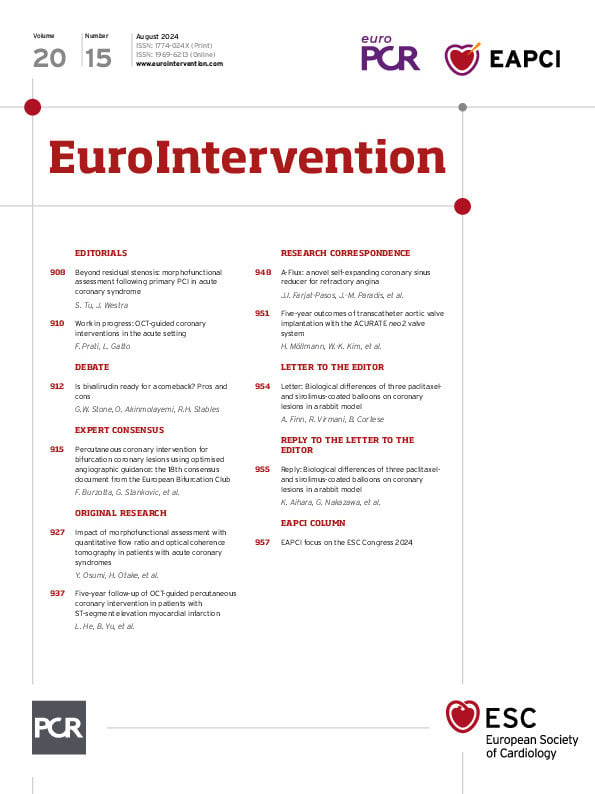Cory:
Unlock Your AI Assistant Now!
Myocardial infarction has acted over time as an insurmountable obstacle to any innovative solution potentially capable of improving patient outcome. Since the adoption of primary angioplasty, which proved to be superior to thrombolysis in this regard, the testing of other pharmaceutical or interventional techniques has drawn a blank each time. Who cannot recall the failure of the randomised studies that evaluated the impact of upstream glycoprotein IIb-IIa inhibitors or low-dose thrombolytic drugs along the pathway of facilitated primary angioplasty12?
In this issue of EuroIntervention, He et al3 have explored, in an original paper, the clinical role of intracoronary imaging in the quest to improve the clinical outcome of ST-elevation myocardial infarction (STEMI). The authors performed a large prospective registry study of 3,897 patients with STEMI, mainly treated with optical coherence tomography (OCT)-guided interventions (69.2%).
Patients in the OCT-guided cohort more commonly had thrombus aspiration and were less often treated with stenting. The 5-year cumulative rates of all-cause and overall mortality were significantly higher in the angiography-guided cohort. Propensity score matching confirmed the effectiveness of OCT guidance in terms of a reduction of all-cause and cardiovascular mortality.
He et al should be congratulated for developing a new concept: the possibility of tailoring the optimal technique for thrombus removal in a large patient dataset with STEMI by studying vessel anatomy from the inside. As over 87% of patients were studied using preinterventional OCT, the authors had a clear perception of the pathophysiology of acute transmural ischaemia and were able to measure the amount of thrombus, whenever present. This latter aspect does not seem trivial. Angiography is not suitable for studying vessel thrombosis; albeit, interventional cardiologists may consider proceeding with thrombus aspiration in the presence of arteries whose size may accommodate massive thrombosis.
A one-size-fits-all strategy of thrombus aspiration does not seem to work4. Consistently, methods of OCT-guided local drug delivery with abciximab have been unsuccessful56. These disappointing results may be due to the variable amount of fresh thrombus at STEMI culprit lesion sites, as shown by OCT studies6. In a substantial number of cases, for several reasons, there is a modest amount of thrombus overlying coronary plaques7. Firstly, antiplatelet drugs and heparin plus the endogenous thrombolytic capabilities are effective in reducing thrombus. Secondly, type 1 myocardial infarction can be caused by an alternative pathophysiology to plaque rupture, including spontaneous acute dissection or vasospasm. Thirdly, type 2 myocardial infarction without thrombosis is an alternative cause of STEMI.
A systematic approach to baseline OCT assessment is therefore very instrumental in selecting the STEMI cases that may benefit from thrombus aspiration. In the same way, a step-by-step imaging approach is useful to measure the residual thrombus amount and lumen area after thrombectomy or balloon dilatation and to help decide whether to avoid stent deployment. In this regard, the study is innovative.
Furthermore, the benefit of OCT-guided coronary intervention in STEMI patients was observed at long-term (5 years) follow-up. Of note, only a few OCT studies have been able to relate OCT findings to long-term outcomes to date8.
The study has, however, methodological limitations to be pointed out. The most important one certainly lies in its retrospective and non-randomised nature. Despite the adoption of an adjunctive propensity score and multivariate analyses applying different models, there remains a selection bias because of the lower clinical and procedural complexity of the OCT-guided arm. Notably the OCT-guided group was characterised by a lower prevalence of past myocardial infarction and diabetes and showed a reduced angiographic complexity (shorter lesions with less thrombus burden).
The use of a propensity matching score to correct baseline demographic and clinical variables is appropriate to smooth out the intergroup disparities in a non-randomised study. However, there remain profound procedural differences between the two cohorts regarding procedural aspects and the adopted drug therapy approach.
It is rather surprising that, in the present study, the higher number of deployed stents in the angio arm (1.4±0.6 vs 1.2±0.5; p<0.001) and the higher percentage of multivessel interventions (6.0% vs 3.5%; p=0.008) was accompanied by a significant increase in cardiovascular events. These data seem in conflict with recent literature9 highlighting the effectiveness of a strategy of removing all significant coronary narrowings in an acute coronary syndrome (ACS) setting. Overall, few cases in the study by He et al3 had multivessel treatment (less than 4% of cases); this emphasises the study approach, which was mainly focused on the optimal treatment of thrombus removal at the culprit site rather than the treatment of non-culprit lesions during index procedures. For this reason, He et al could not address the burning question as to whether the intracoronary imaging interrogation of non-culprit plaques can identify features of vulnerability and reduce the risk of cardiac events, as recently shown by the PREVENT trial10.
Regarding drug therapy, there was an imbalance in the use of ticagrelor in the two groups (52.8% in the angio arm vs 60.3% in the OCT arm; p<0.001) that may justify the higher cardiac events in the angio-guided arm. In fact, the use of a dual antiplatelet therapy with potent P2Y12 inhibitors (either ticagrelor or prasugrel) is a class Ia indication in the ACS clinical subset11 and is a mainstay for the avoidance of acute-subacute stent thrombosis.
In conclusion, the present work by He et al is to us an innovative proof-of-concept study that contributes to the concept of OCT-guided intervention in the acute ACS setting. Further randomised studies are needed to corroborate this assumption.
Conflict of interest statement
F. Prati is a consultant for Abbott, Amgen, and Novo Nordisk; and has received speaker fees/honoraria from Sanofi. L. Gatto has no conflicts of interest to declare.

